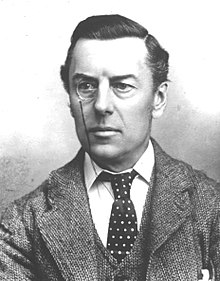monocle

The monocle , also known as a single lens , is a visual aid which, in contrast to the glasses used today ("binoculars", lorgnette ) consists of only one glass and is clamped onto the eye (in contrast to the single lens with a stem ).
The monocle developed from the reading stone , a cut lens made of quartz , especially rock crystal, or beryl , hence the German word glasses . This was placed directly on the document to enlarge it. From the 14th century , the lens was held in front of the eye. In the 16th century the idea arose to clamp the lens through the eyelid muscle directly in front of the eye in order to have both hands free.
The word monocle used in German was borrowed in the 19th century from the synonymous French word monocle , but originally emerged as a bilingual made-up word from ancient Greek μόνος monos for "alone" and the Latin oculus for "eye".
Monocle shapes
A distinction is made between monocles with and without a gallery. In the case of a monocle, a gallery is a clamp carrier edge that consists of two webs on the top and bottom of the monocle. The gallery is up to five millimeters away from the glass and, in addition to providing a better grip, is also intended to keep the glass at a distance from the eyelashes and protect it from soiling. Monocles with a gallery always have a socket. Monocles without a gallery can be supplied with or without a socket. In the case of monocles without a gallery and without a frame, the glass is knurled all around to make it easier to hold. To protect monocles from damage if they fall out, they are usually hung on a thin chain or ribbon. For the uniform, a chain or ribbon was put as a loop around the wearer's neck and pulled together with a slider in front of the collar button. The civilian suit had a button attached to the end of the chain or ribbon that was buttoned into the buttonhole on the lapel of the suit jacket.
history

The monocle was particularly popular in Germany and Great Britain towards the end of the 19th century and was considered a status symbol for the higher social classes. It was particularly widespread in the officer corps of the armies of these two countries - and led to disputes. At the beginning of the 20th century , the later British War Minister Earl Kitchener forbade Army soldiers from using monocles because he saw them as an "outgrowth of silly vanity" that "is unworthy of an officer."
At the time, some medical professionals were of the opinion that contorting the face to hold the monocle was harmful to health. Conversely, it was commonly argued that monocles should only be worn by people who could wear them without such facial distortions. The opticians also met this with different sizes.
As late as the 1920s, it was still a matter of dispute in Great Britain whether the monocle belonged to the optical instruments or, together with glasses, formed a separate category. It concerned the import duties for optical instruments set out in the Finance Act of 1926. On October 6, 1927, a trade committee decided that "visual aids in colloquial language as well as in the normal diction of trade are not optical instruments in the same sense and therefore do not fall into the same class as optical instruments." not the customs regulations for optical devices.
The monocle in art
In caricatures since the end of the 19th century, the monocle is the stereotypical attribute of the mostly noble Prussian (reserve) officer.
In the television series A Cage Full of Heroes , a monocle is the trademark of Colonel Wilhelm Klink .
In the film Eins, Zwei, Drei Otto Ludwig Piffl ( Horst Buchholz ) and Count Waldemar von und zu Droste-Schattenburg ( Hubert von Meyerinck ) seal the adoption by exchanging monocles.
In the film Witness for the Prosecution leads Charles Laughton with Tyrone Power to Monokeltest through by hidden power by reflected light, and will make nervous.
In the horror film classic Frankenstein's Son from 1939 , Inspector Krogh, played by Lionel Atwill , wears a monocle.
In the Batman comics , the opponent, the penguin, is often portrayed with a monocle. He also wears this in numerous adaptations of the comic series, including the Batman live-action series of the 1960s , the animated series Batman: The Animated Series and in the finale of the crime series Gotham .
The trademark of Roberto Rastapopoulos (a character from the Tintin comics) is the monocle, which regularly falls out of his face when he has fits of anger. Captain Haddock, on the other hand, only wears it in The Seven Crystal Balls and loses it on average once on each side.
Trivia
Famous monocle wearers: Fritz Lang , Roda Roda , Erich von Stroheim , Richard Tauber , António de Spínola , Hans von Seeckt , Eberhard von Mackensen , Walter Model , Wilhelm Keitel , Erich von Manstein
Camera lenses that only consist of a single lens (usually a collecting lens) are also called monocles.
See also
- Lorgnon
- Pince-nez
- the clamped to the eye eyepiece of a watchmaker called watchmaker's loupe
- Monocular
Individual evidence
- ↑ Duden . The dictionary of origin. Etymology of the German language from the Duden editorial team, 20,000 words and idioms in approx. 8,000 articles, 3rd, completely revised edition, Dudenverlag, Mannheim / Leipzig / Vienna / Zurich 2001, ISBN 3-411-04073-4
- ^ Siegmund Feldmann: On the natural history of the monocle , in Die Woche , No. 52/1913, p. 2190
- ↑ The Times , October 6, 1927: "Safeguarding Duty on Spectacles."
